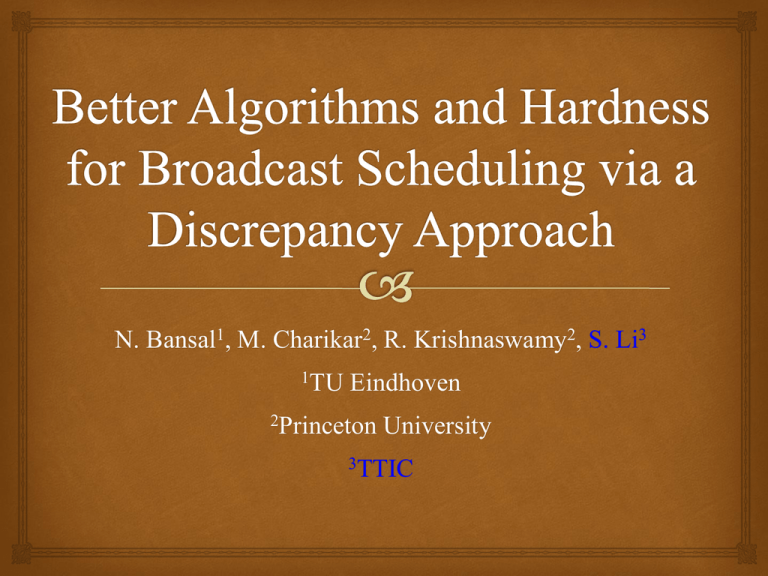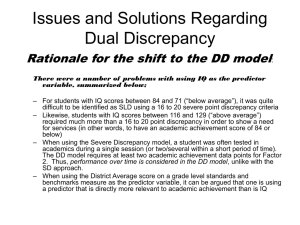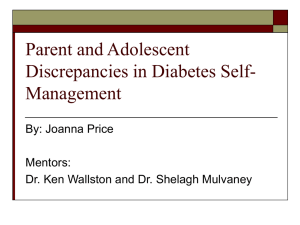short
advertisement

N. Bansal1, M. Charikar2, R. Krishnaswamy2, S. Li3
1TU
Eindhoven
2Princeton
University
3TTIC
Broadcast Scheduling Problem
requests
broadcasts
1
3
5
2
4
5
1
3
4
5
3
response time = 2
1
2
4
5
response time = 3
4
3
2
Time
a server holding n pages
1 2 3 4 5
requests come over time
broadcast 1 page per time slot
all outstanding requests for the page satisfied
minimize average response time
offline version
Our Results
approximation
integrality gap
hardness
previous best
O(log2n) *
1 + tiny const #
NP-hard ~
our results
O(log3/2n)
Ω(log n)
Ω(log1/2 n)
[Bansal-Coppersmith-Sviridenko 08]
# [Bansal-Charikar-Khanna-Naor 05]
~ [Erlebach-Hall 02]
*
Discrepancy Approach
negative results (integrality gap and hardness)
connection to permutation discrepancy
positive result
Lovett-Meka algorithmic framework for discrepancy
minimization
Discrepancy Approach
negative results (integrality gap and hardness)
connection to permutation discrepancy
positive result
Lovett-Meka algorithmic framework for discrepancy
minimization
3-Permutation Discrepancy
give 3 permutations of [n]
find a coloring χ : [n]{±1}
minimize the maximum discrepancy over all
prefixes of the permutations
5 6 3 1 4 2
6 3 1 4 2 5
1 5 2 3 4 6
χ: 1 2 3 4 5 6
discrepancy = 2
Why 3 Permutations?
1 permutation : discrepancy=1, trivial
2 permutations : discrepancy=1, easy exercise
3 permutations?
upper bound : O(log n)
lower bound [Newman-Nikolov 11]: Ω(log n)
l ≥ 3 permutations
upper bound : O(l1/2 log n)
lower bound : max{Ω(l1/2), Ω(log n)}
Negative Results
Main Lemma
l-permutation
instance Π
“discrepancy”
broadcast scheduling
instance I
=
optimal response time
LP(I) = O(1)
Main + Ω(log n)-disc. for 3-perm. Ω(log n)-int. gap
Main + Ω(l1/2)-hard. for l-perm.(new) Ω(log1/2 n)-hard.
Fractional Schedule from LP
response time
0.4×1+0.6×2=1.6
requests
integral
schedule
fractional
schedule
1
3
5
2
4
5
3
4
5
1
2
4
Time
Main Lemma
l-permutation
instance Π
“discrepancy”
broadcast scheduling
instance I
=
optimal response time
LP(I) = O(1)
proof steps:
construction of BS instance from l permutations
Θ(1) LP value
small discrepancy small response time
small response time small discrepancy
Construction of BS Instance
given 3 permutations π1 π2 π3 of size m
π1 = (5, 8, 4, 6, 3, 2, 1, 7)
π2 = (6, 7, 3, 8, 5, 1, 2, 4)
π3 = (7, 1, 3, 2, 8, 5, 6, 4)
m/2
Req:
permutation interval
forbidden interval
P1
P2
P3
P4
P5
P6
5431
8627
5431
8627
6352
7814
6352
7814
7386
1254
7386
1254
π1
π2
π3
P7
Good and Bad Requests
P1
5431
8627
Brd: 3458
Req:
P2
P3
5431
3
8627
6 7
12766
6352
7814
8534
3
P4
P5
P6
P7
6352
7814
6721
7
7386
1254
4835
7386
1254
7216
3485
average response time ≈ # bad requests
new goal: minimize #bad requests
a request in Pi is good if it is satisfied at Pi or Pi+1
otherwise, the request is bad
Θ(1) LP Value
Req:
P1
P2
P3
P4
P5
P6
5431
8627
5431
8627
6352
7814
6352
7814
7386
1254
7386
1254
LP solution
request
½ satisfied
P7
½ satisfied
each time slot, broadcast ½ fraction of each page requested
P7: broadcast ½ fraction of the m pages arbitrarily
all requests are good:
½ of request in Pi is satisfied immediately
remaining ½ satisfied at Pi+1
How to Make All Requests Good
in an Integral Schedule?
P1
5431
8627
Brd: 3421
Req:
P2
P3
P4
P5
P6
P7
5431
8627
5867
6352
7814
4312
6352
7814
6785
7386
1254
1324
7386
1254
7856
3421
all m pages requested in all intervals(except P7)
each P-interval has m/2 slots
solution:
m/2 pages are broadcast in P1, P3, P5, P7
m/2 pages are broadcast in P2, P4, P6
giving a balanced ±1 coloring of the m pages
How to Make All Requests Good
in an Integral Schedule?
P1
5431
8627
Brd: 3421
Req:
P2
P3
P4
P5
P6
P7
5431
8627
5867
6352
3 2
7814
14
4312
6352
7814
6785
7386
1254
1324
7386
1254
7856
3421
enough to make all requests good?
No! Broadcast may be before the request
no bad requests only if two requests at the same
time have different colors
discrepancy of 3-permutation system is 1
Small DiscrepancyFew Bad
Requests
suppose discχ(πi) = d
πi =(1, 10, 2, 6, 8, 7, 3, 11, 5, 12, 4, 9)
χ =(1, 10, 2, 6, 8, 7, 3, 11, 5, 12, 4, 9) d = 2
order of red elements (1,6,3,5,4,9)
right rotate by d-1=1 positions: (9,1,6,3,5,4)
broadcast according to this ordering in P2i-1
#bad quests = d-1
broadcast before request : bad
requests =
1 2 8 3 5 4
10 6 7 11 12 9
broadcasts = 9 1 6 3 5 4
broadcast after request : good
Remarks
“discrepancy” = average discrepancy of l
permutations
size of BS instance is exponential in l
P1
P2
request
P3
good
P4
P5
P6
P7
bad
lengths of forbidden intervals grow exponentially
Discrepancy Approach
negative results (integrality gap and hardness)
connection to permutation discrepancy
positive result
Lovett-Meka algorithmic framework for discrepancy
minimization
Lovett-Meka Framework
A Rm×n, x [0,1]n, b=Ax,
n
m
A
“error”
n
×
x
=
b
λ1, λ2, …, λm s.t.
A
m
å
m
i=1
e
- li2
n
£
16
×
y
=
b
±λ1||A1||
±λ2||A2||
±λ3||A3||
...
±λm||Am||
output: y [0,1]n, s.t. ½ fraction of coordinates in
y are integral
Tentative Scheduling
we may broadcast more than 1 page at a time slot
# broadcast between s and t ) - (t - s +1))
(
(
backlog = max
s£t
6 time slots, 11 broadcast, backlog = 5
tentative schedule of backlog b valid schedule,
with additive b loss in the average response time
Goal
assumptions:
fractional schedule is ½-intergal
every page is broadcast ≤ Δ = O(log n) times
# timeslots ≤ 2Δ × n
locally consistent distributions
with probability 1/2
with probability 1/2
Interesting Intervals
# time slots ≤ 2Δ × n
64Δ
λ= 0
λ= 1
λ= 2
…
……
å
m
i=1
e
- li2
n i -i2 n
£å
2e £
i=0 32
16
¥
“error”£ 2å¥i=0 i
64D
=Q
i
2
( D) = Q(
logn
)
repeat log n times : backlog = O(log3/2n)
Summary
approximation
integrality gap
hardness
previous best
O(log2n)
1 + tiny const
NP-hard
our results
O(log3/2n)
Ω(log n)
Ω(log1/2 n)
Open problems
hardness for 3-permutation(implying the same hardness
for broadcast scheduling)
discrepancy of l-permutation?
Questions?







